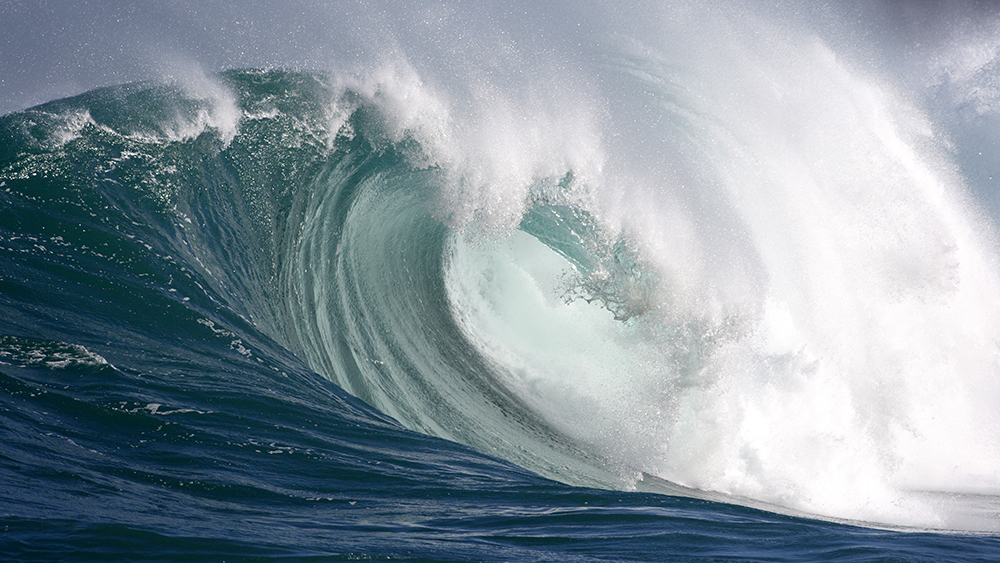In the U.S. Gulf Coast region, the Upper Jurassic Norphlet Sandstone rests right on top of thousands of feet of Middle Jurassic salt, known as the Louann Salt. Secular geologists believe this sandstone layer was deposited by the windblown accumulation of sand in an arid environment. These kinds of deposits are commonly called aeolian deposits.1
Secular scientists never address or explain exactly how this claimed desert deposit supposedly formed across much of the offshore Gulf of Mexico region and came to lie directly on top of thick salt beds. And recent discoveries in deep water make this interpretation even more improbable as the sand layer is far more extensive than originally thought.1
The Upper Jurassic Norphlet Sandstone was first described onshore at Norphlet, Arkansas. It’s been drilled for natural gas and oil for many years in places like Mobile Bay, Alabama, and in the shallow-water regions of the Gulf of Mexico. The Norphlet averages less than 300 feet thick near the Gulf Coast, but thickens to closer to 1000 feet in the deepwater Gulf of Mexico.1 The first well drilled in the deep water with the Norphlet as a target was begun in 2003 in the offshore region referred to as De Soto Canyon.2 Since then, numerous wells have been drilled in deeper and deeper water.
The Norphlet is another case where uniformitarian geology fails. ![]()
In 2018, several large discoveries in the Norphlet in deepwater Gulf of Mexico were reported by Shell and Chevron. Chevron announced a Norphlet discovery at their Ballymore prospect in 6,536 feet of water in the area known as Mississippi Canyon, south of Louisiana. This well was drilled to 29,194 feet and found 670 feet of net pay in the Norphlet.1 (“Net pay” refers to the part of the sandstone layer with enough permeability in the wellbore to produce oil.)
Also, in 2018, Shell announced a Norphlet well at their Dover prospect about 170 miles south of the Louisiana coastline. This well was drilled in 7,500 feet of water in the Mississippi Canyon protraction also, finding 800 feet of net pay.1
Shell’s Louise Durham reported, “This is the company’s sixth discovery in the Jurassic-age Norphlet geologic play in the Gulf. It joins such high-profile finds as Appomattox, approximately 13 miles away.” She continued, “The Norphlet ranks as the first extensive post-salt deposit in the central Gulf Coast.”1
Not only has the Norphlet now been found to extend into the deepwater portion of the Gulf of Mexico, but it may also continue right across the Gulf of Mexico as a blanket sandstone bed to the offshore region of the Yucatan Peninsula, Mexico.2 This sand bed covers an area that is “several hundred thousand square kilometers across Louisiana, Mississippi and Alabama and outward into the deepwater Gulf.”1
Essentially, this is another Whopper Sand.3 But it was deposited earlier in the rock record than the original. It’s comparable in size to the Ogallala Sandstone bed that extends for 174,000 square miles across the Great Plains states.4
The Norphlet is the newest deepwater oil and gas target. And yet its massive extent cannot be adequately explained by conventional models, let alone with an aeolian interpretation. How did a thick “desert” sandstone just happen to become spread across nearly the entire deepwater Gulf and on top of thousands of feet of pure salt? And how did this thick sandstone bed get nearly 200 miles offshore? Uniformitarian scientists have provided no answers, yet they continue to find more sand and oil in the Norphlet.
Salt beds are only deposited in an underwater marine setting. So how did the ocean mysteriously and suddenly disappear, exposing a massive pure salt layer, and then become a terrestrial desert landscape all in the blink of an eye?
Sadly, secular geologists merely label any sandstone that has large cross-beds as aeolian, like they did with the Coconino Sandstone in Grand Canyon. And yet the Coconino contains minerals like carbonate ooids and flakes of mica minerals that cannot form in an aeolian environment.5,6 The ooids and minerals are best explained by a marine deposit.
Blanket sands are best explained as massive Flood deposits as the waters advanced and/or retreated. ![]()
The Norphlet is another case where uniformitarian geology fails. Blanket sands are best explained as massive Flood deposits as the waters advanced and/or retreated. The Norphlet appears to be a mid-Flood deposit near the base of the Zuni Megasequence. Rapid shifts in rocks types (i.e., from salt to sandstone) are best explained by sudden shifts in direction of tsunami-like waves, bringing in sediment from different locations and sources during the Flood.
References
1. Durham, L. S. 2018. Shell makes large discovery on Deepwater GoM. AAPG Explorer. 39 (7): 24-25.
2. Saunders, M. et al. 2017. Mapping the Jurassic Norphlet Sandstone along the northern margin of the Yucatan Peninsula. AAPG Datapages/Search and Discovery Article #90291. AAPG Annual Convention and Exhibition, Houston, Texas, April 2-5, 2017.
3. Clarey, T. 2015. The Whopper Sand. Acts & Facts. 44 (3): 14.
4. Clarey, T. 2018. Palo Duro Canyon Rocks Showcase Genesis Flood. Creation Science Update. Acts & Facts. 47 (7): 10.
5. Cheung, S. et al. 2009. Occurrence of dolomite beds, clasts, ooids and unidentified microfossils in the Coconino Sandstone, Northern Arizona. Geological Society of America Abstracts with Programs. 41 (7): 119.
6. Whitmore, J. H., R. Strom. 2010. Petrographic analysis of the Coconino Sandstone, Northern and Central Arizona. Geological Society of America Abstracts with Programs. 41 (7): 122.
*Dr. Timothy Clarey is Research Associate is at ICR and earned a doctorate in geology from Western Michigan University.





















